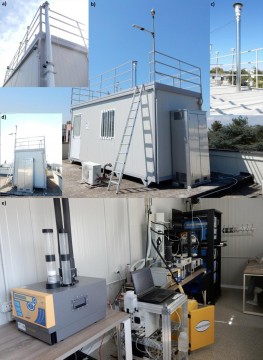Region: Puglia
Position: Lat: 40°3’N Long: 18°1’E
Description of the site
TheCNR-ISAC station in Lecce is located about 4 km (SW) of the urban area and it can be classified as an “urban background” site. The site is located at about 30 km and 80 km from the most important industrial centres of the Puglia Region (Taranto and Brindisi). As highlighted by Mangia et al. (2004), in addition to the synoptic scale (here described thanks to the use of a model to calculate 3D-retro-trajectories of air masses, see Figure LE-1), thermic contrast between earth and maritime surface has a crucial role in determining atmospheric circulation in the region of the strengthening site. This thanks to the development of a complex system of sea-earth breezes which extend inside the Salentina peninsula.
Picture LE-1: Frequency field of 120 hours retro-trajectories of air masses calculated at 12 from 2006 – 2011 thanks to the HYSPLIT model starting from the NCEP-GADS meteorological data. The colors indicate frequency values (%) of trajectories on the 1°x 1° grid.
Description of the Environmental-Climate Observatory
The observatory is accommodated in a shelter located on the roof of the Institute of Atmospheric Sciences and Climate (Division of Lecce), at about 12 m above the street, inside the University Campus (Figure LE-2). The observatory is used for the collection of environmental continuous data related to local meteorology, various gaseous pollutants concentration and different atmospheric particulate fraction. The instrumental check, the data acquisition and data analysis are remotely managed through internet.
FigureLE-2: Outside and inside photos of the Observatory
The roof of the shelter is equipped to take real-time meteorological measurements using a radiometer (Kipp & Zonen, mod. CNR4), that measures solar and thermic radiation, and an automatic wheatear station (Vaisala, mod. WXT520) for the main meteorological parameters acquisition (Figure Le-2 b). On the roof of the observatory there are sampling probes for gas and aerosol connected to the measurement instruments located inside the shelter.
Outside the observatory there is a booth (Figure LE-02 d), which hosts the mixtures of pure gases needed for periodic calibration of gas concentration detectors and a telescopic mast to measure particle number concentration and vertical particle fluxes, using the Eddy-Covariance method (Figure LE-02 a) by an Ultrafine Condensation Particle Counter UCPC (TSI, mod. 3776) and an ultrasonic anemometer Gill R3.
The interior of the shelter is equipped with different instruments for atmospheric and environmental measurements (Figure Le-2 e):
-
Heated gas sampling probe (General Impianti srl) with conditioning of temperature to control relative humidity, connected to a 11 valves manifold.
-
Aerosol sampling probe, PM10 cut-off, with 10 valves manifold equipped with a high volume pump (Mega System srl, mod. X1-Hornet).
-
Measurements of particle size distribution in the following intervals:
-
from 8 nm to 800 nm: Scanning Mobility Particle Sizer (SMPS produced by the Tropos- Leibniz Institute for Tropospheric Research, in compliance with Actris specifications).
-
from 0.28 µm to 10 µm: Optical Particle Counter (OPC FAI instruments, mod. Multichannel).
-
Particulate sampler (FAI Instruments, mod. SWAM5a Dual Channel) which measures the PM2.5 and PM10 mass concentrations using the measuring principle based on attenuation of β ray.
-
Measurements of Black Carbon concentrations in atmosphere by a Multi Angle Absorption Photometer (Thermoscientific, mod. 5012).
-
Measure of atmospheric aerosol back scattering coefficient by a Nephelometer (TSI, mod. 3560).
-
Measurements of gaseous concentrations, CO, CO2, CH4 and water vapour, by a detector PICARRO (mod. G2401).
-
Measurements of gaseous concentrations by an ozone automatic analysers (Thermoscientific, mod. 49i) and a nitrogen oxides analysers (Thermoscientific, mod. 42i-TL).
-
Measurements of the columnar content of gaseous pollutants by a spectrophotometer DOAS which is provided with an external measuring head (located on the observatory roof) connected to the spectrophotometer by optics fibres.
-
Calibration systems for gas detectors: Multipoint calibrator (Thermoscientific, mod. 146i) used for the nitrogen oxides calibration, ozone generator (Thermoscientific, mod. 49i-PS) for the ozone concentration analyser and zero air generation (Thermoscientific, mod. 146i).
-
A server station with monitor that communicates with the various instruments and stores the data. The server station operates as a vehicle for the display and the remote data transfer. It is connected to a data logger Campbell Scientific CR1000 with a buffer battery.
More information on the equipment installed at the Environmental-Climate Observatory are available at the following address : http://vulcano.le.isac.cnr.it/poster/Conte_Workshop_IAMICA_2015A.pdf.
Recent principal scientific results
The main scientific results obtained in the last few years at the observatory site regard the variability of the atmosphere composition (e.g. Contini et al., 2010), the micrometeorology (e.g. Cava et al., 2008) and the meteorology (e.g. Mangia et al., 2004).
A study on PM10 chemical characterization in the period from January 2007 to January 2008 (mean value: 26 mg m-3) allowed to identify the main sources that modulate the variability: crustal material (49.5%), inorganic secondary aerosol (24.1%), marine aerosol (6.3%), traffic (16.5%), industrial activities (2.1%). These analyses showed that the seasonal of PM10 in the station ISAC area is characterized by a trend, opposite to that underling in the Northern part of Italy, with higher values in spring-summer and lower values during the winter. The different trend can be explained in terms of the major contribution of the mineral aerosol from the north Africa (Contini et al., 2014a).
A study (Contini et al., 2014b) on the water soluble components of atmospheric particulate collected in size-segregated mode with a multi stage cascade (MOUDI-II) was made in the observatory area. The results showed the presence of calcium and magnesium carbonates in the coarse fraction (particles with diameter > 1 µm), ammonium sulphate in the fine fraction (diameter < 1 µm) and sodium nitrate in the coarse fraction.
A methodology has been developed (Donateo et al., 2006) to evaluate the PM2.5 vertical fluxes, coupling aerosol optical measures with ultrasonic anemometers. This methodology has been useful to differentiate the contributions of local aerosol sources (emissions from industries or from ground level) with respect to sources far from measurement site.
Moreover, other studies on the evaluation of the PBL’s level have been carried out: in particular, the comparison among different methodologies allowed to conclude that spectral methods applied to sonic anemometers measurements may represent a valuable resource for operational applications related to the estimate of the atmospheric boundary layer.
References:
Cava, D., Contini, D., Donateo, A., Martano, P.: Analysis of short-term closure of the surface energy balance above short vegetation, Agricultural and forest meteorology 14 8, 82-93, 2008.
Contini, D., Cava, D., Martano, P., Donateo, A., Grasso, F. M.: Comparison of indirect methods for the estimation of Boundary Layer height over flat-terrain in a coastal site, Meteorologische Zeitschrift, 18- 3, 309-320 (12), 2009.
Contini, D., Genga, A., Cesari, D., Siciliano, M., Donateo, A., Bove, M.C., Guascito, M.R.: Characterisation and source apportionment of PM10 in an urban background site in Lecce, Atmospheric Research, 95, 1, 40-54, 2010.
Contini, D., Cesari, D., Donateo, A., Chirizzi, D., Belosi, F.: Characterization of PM10 and PM2.5 and Their Metals Content in Different Typologies of Sites in South-Eastern Italy, Atmosphere, 5, 435-453, 2014a.
Contini, D., Cesari, D., Genga, A., Siciliano, M., Ielpo, P., Guascito, M.R., Conte, M.: Source apportionment of size-segregated atmospheric particles based on the major water-soluble components in Lecce (Italy), Science of the Total Environment, 472, 248–261, 2014b.
Donateo, A., Contini, D., Belosi, F.: Real time measurements of PM2.5 concentrations and vertical turbulent fluxes using an optical detector, Atmospheric Environment, 40, 7, 1346-1360, 2006.
Mangia, C., Martano, P., Miglietta, M. M., Morabito A., and Tanzarella, A.: Modelling local winds over the Salento peninsula. Meteorological Applications, 11, 231-244, 2004.








